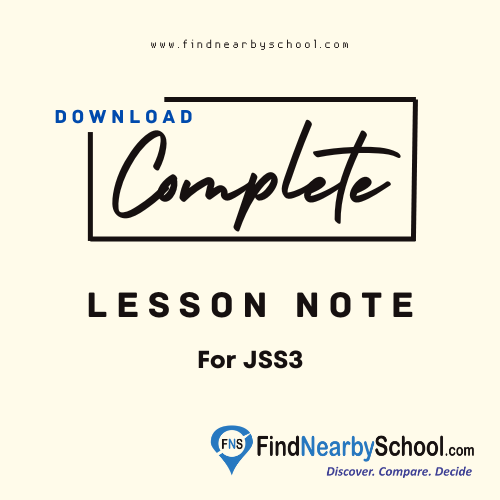Description
JSS3 Mathematics Scheme of Work for First, Second and Third Term: These lesson notes cover the following topics.
First Term Scheme:
- 1 Revision of JSS 2 work
2 The Binary number system
3 Binary number system continued
4 Algebraic Processes
5 Word problems
6 Change of subject of formulae
7 Revision of first half terms work and periodic test
8 Statistics
9 Statistics Continued
10 Simple equations involving fraction and simultaneous equations
11 Revision of 2nd half term’s lesson and periodic test
12-13 First term examinationREFERENCE MATERIALS
ESSENTIAL MATHEMATICS for junior secondary school, book 3 by A. J. S Oluwasanmi
EFFECTIVE MATHEMATICS for junior secondary school book 3 by M.K.Akinsola, M.C.Ejike and A.Tella
Second Term Scheme:
- 1. Revision of first term work
2. Simple Equations involving Fractions: Simple Equations involving fractions. Word problems leading to simple equations involving fractions
3. Simultaneous Linear equations: Compilations of tables of values. Graphical solution of simultaneous linear equations in two variables.
4. Solution of simultaneous linear equations: Method by elimination and method by substitution.
5. Similar shapes: identification of similar figures-triangles, rectangles, squares, cubes and cuboids. Enlargement and scale factor
6. Use of scale factor in calculating lengths, areas and volumes of similar figures.
7. Trigonometry: the sine, cosine and tangent of an acute angle. Applications of Tri gonometrical ratios to finding distances and lengths
8. Area of plane Figures: Area of plane figures-Triangles, parallelogram, trapezium and circle. Calculations of the areas of lands
9. Construction: Bisection of a segment-using a pair of compasses and a ruler. Bisection of an angle. Construction of angles 900, 450, 600 and 300. Copying giving angles. Solving quantitative reasoning aptitude problems on construction.
10. Revision.
11. Examination.
Third Term Scheme:
1. Revision of First term’s work
2. Methods of solving simultaneous Linear Equations in one or Two Variables
Elimination, Substitution and Graphical Methods
3. Methods of solving simultaneous Equation.
Application of Linear Equation
Graphical Method continued
4. Statistics II
Application of measure of central tendency on relevant current issues
Data collection from info on drug Abuse, voters Register, Producers (workers), consumers (children, aged etc)
Importance of data on drug. Abuse, HIV patients, Voters Register, Producers, consumers etc
The use of the statistical tools such as measures of central tendency in Drug abuse, voting and other related activities.
5. Variation
Concept and meaning
Types of variation with examples Direct, Inverse, Joint, and Partial.
6. Variation (continued)
Joint and Partial Variation on simple exercises
More exercise in the various types of variation
7. Revision
8. Trigonometric ratio of angles
Sine, cosine, tangent of acute angles
Application of trigonometrically ratios to solve problems on angles and sides of a
9. Angles of elevation and depression
Clinometers to measure distances.
10. Bearing and Distances.
Concept of bearing and distances
Taking of bearing
Instrumental for taking bearing
Scale drawing
11 – 13 Revision & Examination




Reviews
There are no reviews yet.